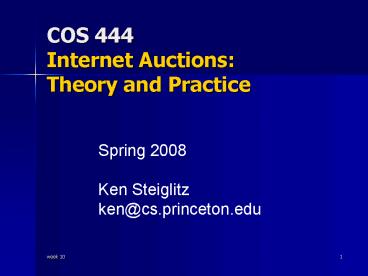COS 444 Internet Auctions: Theory and Practice - PowerPoint PPT Presentation
1 / 26
Title:
COS 444 Internet Auctions: Theory and Practice
Description:
... in a mechanism have no incentive to lie about their values, we say the mechanism ... simply by being truthful, and there is never an incentive to lie. ... – PowerPoint PPT presentation
Number of Views:20
Avg rating:3.0/5.0
Title: COS 444 Internet Auctions: Theory and Practice
1
COS 444 Internet AuctionsTheory and Practice
Spring 2008 Ken Steiglitz
ken_at_cs.princeton.edu
2
?
3
Moving to asymmetric bidders
- Efficiency item goes to bidder with highest
value - Very important in some situations!
- Second-price auctions remain efficient in
asymmetic (IPV) case - First-price auctions do not
4
Inefficiency in FP with asymmetric bidders
5
New setup Myerson 81
- Vector of values v
- Allocation function Q (v )
- Qi (v ) is prob. i wins item
- Payment function P (v )
- Pi (v ) is expected payment of i
- Subsumes Ars easily (check SP, FP)
- The pair (Q , P ) is called a
- Direct Mechanism
6
New setup Myerson 81
- Definition When agents who participate in a
mechanism have no incentive to lie about their
values, we say the mechanism is incentive
compatible. - The Revelation Principle In so far as
equilibrium behavior is concerned, any auction
can be replaced by an incentive-compatible
mechanism.
7
Revelation Principle
- Proof Replace the bid-taker with a direct
mechanism that computes equilibrium values for
the bidders. Then a bidder can bid equilibrium
simply by being truthful, and there is never an
incentive to lie.
8
(No Transcript)
9
Asymmetric bidders
- We can therefore restrict attention to incentive
compatible direct mechanisms! - In the asymmetric case, surplus is no longer vi
F(z) n-1 - P(z) - (bidding as if value z )
- Next we write expected surplus in the
asymmetric case
10
Asymmetric bidders
- Notation v-i vector v with the i th
- Value omitted. Then the prob. that i wins is
- Where V-i is the space of all vs except vi and
- F (v-i ) is the corresponding distribution
11
Asymmetric bidders
- Similarly for the expected payment of bidder i
- Expected surplus is then
12
Asymmetric bidders yet more
general RE
- Differentiate wrt z and set to zero when z vi
- as usual
- But now take the total derivative wrt vi when z
vi - And so
13
Asymmetric bidders yet more
general RE
- Integrate
- or
- (S vQ - P )
- ?Expected payment of every bidder depends only on
allocation function Q !
14
Optimal allocation
- Average over vi and proceed as in RS81
- where
15
Optimal allocation, cont
- The total expected revenue is
- For participation, Pi (0 ) 0, and seller
chooses Pi (0) 0 to max surplus. Therefore
16
Optimal allocation, cont
When Pi (0 ) 0 we say bidders are individually
rational The dont participate in auctions if
the expected payment with zero value is positive.
17
Optimal allocation
- The optimal allocation can now be seen by
inspection! - Look for the maximum value of MRi (vi ). Say it
occurs at i i , and denote it by MR . - If MR gt 0, then choose that Q i to be 1 and all
the other Qs to be 0 (bidder i gets the item) - If MR 0, then hold on to the item (seller
retains item)
18
Optimal allocation (inefficient!)
19
Payment rule
- Hint must reduce to second-price when bidders
are symmetric - Therefore Pay the least you can while still
maintaining the highest MR - Verify This is incentive compatible that is,
bidders bid truthfully!
20
Wrinkle
- For this argument to work, MR must be an
increasing function. We F s with increasing MRs
regular. (Uniform OK) - Its sufficient for the inverse hazard rate (1
F ) /f to be decreasing. - Can be fixed See Myerson 81 (ironing)
- Assume MR is regular in what follows
21
- Notice that this shows that all the auctions in
Ars in the symmetric case are optimal auctions.
(SP is, and the rest are revenue equivalent.) - Notice also that this asks a lot in the
asymmetric case. In the direct mechanism the
bidders must understand enough to be truthful,
and accept the fact that the highest value
doesnt always win.
22
Ars are optimal mechanisms!
- By the revelation principle, we can restrict
attention to direct mechanisms - All direct mechanisms with the same allocation
rule have the same revenue - An optimal mechanism in the symmetric case awards
item to highest-value bidder, and so does any
auction in Ars - Therefore any auction in Ars has the same
allocation rule, and hence revenue, as an optimal
(general!) mechanism
23
Laboratory Evidence
- Generally, there are three kinds of empirical
methodologies - Field observations
- Field experiments
- Laboratory experiments
- ?Problem do people behave the same way in the
lab as in the world? - ?Problem people differ in experience people
learn
24
Laboratory Evidence
- Conclusions fall into two general categories
- Revenue ranking
- Point predictions (usually revenue relative to
Nash equilibrium)
25
Best results for IPV model
- First-Price gt Dutch Coppinger et al. (80)
- First-Price gt Nash Dyer et al. (89)
- Second-Price gt English Kagel et al. (87)
- English ? truthfulNash Kagel et al. (87)
- First-Price ? Second-Price
- Thus, generally,
- sealed versions gt open versions!
26
- See also Kagel Levin 93 for experiments with
3rd price auctions that test IPV theory - More about experimental results for common-value
auctions later - We next focus a while on
- First-price gt Nash
- One explanation risk aversion
- But is there another explanation































